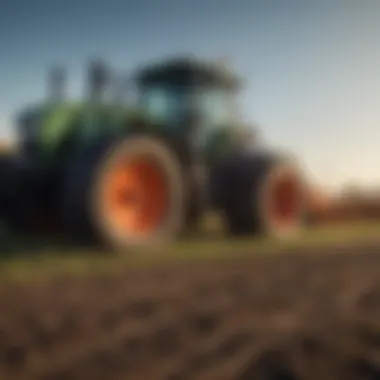Exploring Modern Agriculture: Sustainable Practices and Innovations


Intro
Modern agriculture has become a focal point in discussions around sustainability and food security. It plays a crucial role in how we feed a growing global population. Understanding the depths of this field involves unpacking various concepts and practices that drive innovation in crop management and soil health.
Key Concepts and Terminology
Definition of Terms
To grasp modern agriculture effectively, one must familiarize with several key terms.
- Sustainable Agriculture: Practices that maintain the health of the land and community, focusing on long-term viability rather than short-term gains.
- Precision Farming: Utilizing technology to monitor and manage field variability in crops, maximizing yield and minimizing inputs.
- Crop Rotation: The practice of alternating different crops on the same land to improve soil health and reduce pest issues.
Overview of Relevant Practices
Several practices are essential for modern agriculture:
- Integrated Pest Management (IPM): Combines biological, cultural, physical, and chemical tools to manage pests and reduce reliance on harmful pesticides.
- Conservation Tillage: Reduces soil erosion and improves soil health by minimizing the amount of tillage conducted.
- Agroforestry: Integrates trees and shrubs into crop and animal farming systems, creating environmental and economic benefits.
Current Trends and Innovations
Latest Research and Developments
Recent studies focus on improving soil health and developing more resilient crop varieties. Research has shown that soil microbiomes play a critical role in plant health and productivity. Various institutions are investing in research related to
- Bioengineering crops for better drought resistance.
- Utilizing cover crops to improve soil structure and fertility.
Emerging Technologies and Tools
Technology is transforming agriculture. Noteworthy innovations include:
- Drones: Used for monitoring crop health and assessing field conditions.
- IoT Devices: Sensors that collect real-time data on soil moisture and nutrient levels.
- Mobile Apps: Provide farmers with data analysis and weather forecasting to make informed decisions.
Practical Applications
Step-by-Step Guides
Farmers seeking to implement sustainable practices can follow these steps:
- Assess Current Practices: Evaluate existing farming methods and their impact on soil and crops.
- Research Sustainable Options: Look into methods such as crop rotation and cover cropping.
- Implement Changes Gradually: Introduce new practices slowly to gauge their effectiveness.
- Monitor and Analyze Results: Collect data to understand the benefits and areas for improvement.
Troubleshooting Common Issues
Common challenges include pest management and soil degradation. Suggested approaches involve:
- Conducting regular soil tests to monitor nutrient levels.
- Implementing IPM to control pest outbreaks without harming beneficial organisms.
"Understanding and adapting to changes in modern agriculture ensures that we are not only feeding today’s populations but also future generations."
For more resources, you may refer to Wikipedia, Britannica, Reddit, and Facebook.
The Evolution of Agriculture
Agriculture has undergone significant transformation throughout its history and understanding this evolution is crucial in grasping the complexities of modern farming. This section explores the historical milestones that have shaped agriculture, the technological advancements that revolutionized practices, and the role of innovation in addressing contemporary challenges. By studying the evolution of agriculture, we gain insights into present practices and the potential future of farming.
Historical Context
The roots of agriculture can be traced back over 10,000 years when humans transitioned from nomadic lifestyles to settled farming. This shift allowed for the domestication of plants and animals, fundamentally altering food production and societal structures. Key historical events, such as the Green Revolution in the 20th century, introduced high-yield varieties and chemical fertilizers that drastically increased food production. However, this growth came with consequences, including environmental degradation and loss of biodiversity.


Understanding this context is vital for agricultural professionals today. It provides perspective on current practices and underscores the importance of integrating sustainable methods to counteract past mistakes. The lessons learned from history inform new strategies that are both efficient and eco-friendly.
Technological Advancements
Technological innovation has played a pivotal role in agricultural development. From the invention of the plow to the introduction of genetically modified organisms (GMOs), advancements have continuously shaped how food is grown. Modern technologies such as precision agriculture leverage data analytics, GPS, and drones to optimize yields while minimizing resource input. This level of sophistication allows farmers to monitor crop health in real-time and apply resources where they are most needed.
Additionally, automation in farming, through machines such as robotic harvesters and automated irrigation systems, enhances efficiency. These technologies not only improve productivity but also provide a route towards more environmentally sustainable farming practices by reducing waste. Keeping pace with these advancements is essential for individuals in the agriculture sector, ensuring they remain competitive in a rapidly changing landscape.
The Role of Innovation
Innovation is at the heart of agricultural evolution. It drives the search for solutions to pressing challenges such as climate change, soil degradation, and food security. Initiatives that emphasize research and development play a key role in fostering innovation within the industry. Collaboration between universities, agricultural companies, and research institutions leads to the development of new crop varieties that are more resilient to pests, diseases, and climate variability.
Moreover, farmer-led innovations are increasingly important. Local knowledge can spark unique solutions tailored to specific environments, enhancing sustainability and profitability. Thus, promoting a culture of innovation is crucial for modern agriculture, enabling farmers to adapt and thrive in an ever-evolving context.
"Innovation in agriculture is not just about technology; it encompasses evolving practices that respect the environment and support community resilience."
Sustainability in Agriculture
Sustainability in agriculture has become crucial as the world faces increasing environmental challenges. This concept seeks to balance agricultural production with the health of ecosystems. Sustainable practices aim to reduce negative impacts on the environment while increasing food security. In this section, we will explore the definition of sustainability, key principles of sustainable farming, and the benefits that arise from these practices.
Defining Sustainability
Sustainability, in the context of agriculture, refers to the ability to maintain production systems without causing long-term harm to the environment or depleting resources. It encompasses the responsible use of natural resources, such as soil, water, and biodiversity. Importantly, sustainability supports economic viability for farmers and rural communities. This approach promotes practices that ensure food production remains viable for future generations. The focus is not only on immediate yields but on the long-term health of agricultural systems.
Principles of Sustainable Farming
There are several core principles that underpin sustainable farming:
- Resource Efficiency: Making the most of inputs while minimizing waste is essential. This includes optimizing water use and reducing dependency on chemical fertilizers.
- Soil Management: Healthy soil is the foundation of sustainable agriculture. Practices like cover cropping and reduced tillage help maintain soil fertility.
- Crop Diversification: Growing a variety of crops can enhance resilience to pests and diseases, and improve soil health.
- Ecosystem Balance: Maintaining biodiversity and the natural balance of ecosystems supports sustainable agricultural practices. This can involve integrating wildlife conservation into farming techniques.
- Community Involvement: Engaging local communities fosters knowledge sharing. This enables farmers to adopt best practices that suit their specific environment.
Benefits of Sustainable Practices
Adopting sustainable agricultural practices offers significant benefits:
- Environmental Preservation: Sustainable practices help protect ecosystems and biodiversity. This ensures that wildlife habitats are maintained.
- Economic Benefits: Sustainable farming can reduce costs over time due to lower input needs. Farmers may also access premium markets where consumers are willing to pay more for sustainably produced goods.
- Improved Food Security: By maintaining healthy ecosystems, sustainable practices increase resilience against climate change impacts, leading to less crop loss.
- Social Benefits: These practices support local economies and promote community well-being through education and shared resources.
"Sustainable agriculture is not just about growing more food; it’s about growing food in ways that do not compromise our planet’s health for future generations."
The conversation around sustainability in agriculture is not only about theory. It demands actionable strategies and meaningful community engagement. As stakeholders engage deeply, agricultural practices evolve, reflecting a commitment to a sustainable future.
Crop Management Strategies
Crop Management Strategies are critical in achieving agricultural sustainability and productivity. Effective crop management not only enhances yield but also ensures the long-term health of the farmland. Understanding various components of crop management can lead to improved soil quality, reduced pest issues, and optimized use of resources. This section will explore various strategies, focusing on soil health assessment, integrated pest management, and crop rotation techniques.
Soil Health Assessment
Understanding Soil Composition
Understanding Soil Composition is essential for any agricultural endeavor. This aspect involves analyzing the physical, chemical, and biological properties of soil. An accurate grasp on soil composition helps in making informed decisions regarding crop selection and cultivation practices. A key characteristic of soil composition is its ability to support root growth and nutrient availability. This makes it a beneficial choice for optimizing crop yields. A unique feature of acknowledging soil composition is the insight it provides into soil amendments needed for improvement. However, challenges can arise, such as varying soil types across different areas and needing consistent monitoring.
Evaluating Nutrient Levels
Evaluating Nutrient Levels is another vital aspect of soil health assessment. It focuses on measuring essential nutrients available to crops, such as nitrogen, phosphorus, and potassium. By regularly evaluating these levels, farmers can ensure that crops receive the right nutrients at the right time. A key characteristic of evaluating nutrient levels is its direct correlation to crop performance. This measurement method is popular due to its significant impact on optimizing inputs and minimizing waste. A unique feature of evaluating nutrient levels is the possibility to tailor fertilization plans to specific crop needs. However, one downside is that over-reliance on nutrient evaluation can lead to oversight of other important factors like soil texture or organic matter content.
Integrated Pest Management
Identifying Pests
Identifying Pests is a critical first step in Integrated Pest Management (IPM). Recognizing the different types of pests that may affect crops can lead to quicker and more effective management strategies. A key characteristic of identifying pests is the use of various methods, including visual inspections, traps, and technology like pheromone lures. This method is beneficial for reducing the reliance on chemicals and maintaining ecological balance. A unique feature of accurate pest identification is its role in preventing potential infestations before they escalate. However, it demands continual education and awareness, as pests can change over time or become resistant to control measures.


Employing Control Measures
Employing Control Measures entails the development and application of action plans to manage pests effectively. This may include biological, chemical, and cultural control options. A key characteristic of control measures is their adaptability based on the pest life cycle and crop development stage. This adaptability makes it a beneficial practice within IPM strategies. A unique feature of employing control measures is the emphasis on sustainable practices that lessen chemical dependencies. However, challenges may emerge in ensuring all control options align with organic standards or regulations.
Crop Rotation Techniques
Benefits of Crop Rotation
Benefits of Crop Rotation include improved soil health, reduced pest and disease prevalence, and enhanced biodiversity. Changing the type of crop grown in a specific area each season prevents nutrient depletion and helps maintain soil structure. A key characteristic of this practice is its long-term sustainability. This feature makes crop rotation a beneficial choice for fostering resilient farming systems. Its unique aspect lies in the potential for increased yield and reduced need for chemical fertilizers. Nevertheless, careful planning is necessary to maximize these benefits fully.
Planning Crop Cycles
Planning Crop Cycles is essential for maximizing the efficiency of crop rotation. It involves scheduling different crops throughout the seasons to optimize growth conditions and minimize nutrient competition. A key characteristic of planning crop cycles is the strategic alignment of crop needs and environmental conditions. This thoughtful approach benefits overall farm productivity. An important aspect of planning is the ability to cater for market demands, ensuring profitability. However, one potential disadvantage is the complexity in managing multiple crop schedules, which may require more resources and planning.
Innovative Technologies in Agriculture
Innovative technologies hold a crucial position in the landscape of modern agriculture. They enable farmers to enhance productivity and sustainability, addressing some of the complex challenges associated with food production. Through the integration of cutting-edge tools and techniques, agriculture can become more efficient, environmentally friendly, and responsive to the needs of the market. Technologies like precision agriculture, smart irrigation systems, and biotechnology applications are not just trends; they are transforming agricultural practices on a global scale.
Precision Agriculture
Use of Drones
Drones are increasingly used in agriculture for their ability to collect data and monitor crop health. They provide real-time insights on field conditions that were previously difficult to obtain. This capability allows farmers to base their decisions on accurate information rather than assumptions. A key characteristic of drones is their versatility; they can be equipped with multiple sensors. This feature enables them to assess variables like moisture levels and pest infestations effectively. The advantages of using drones include time-saving and reduced labor costs, although initial investment and training can prove to be challenges for some farmers.
Data Analytics in Farming
Data analytics has become a vital tool in agricultural decision-making. It involves analyzing large datasets from various sources, including weather patterns and crop yields. This process helps farmers understand trends and predict outcomes effectively. The core benefit of data analytics lies in its ability to improve precision in farming practices. By understanding data-driven insights, farmers can optimize resource use and increase yields. However, the requirement for adequate data infrastructure may pose a barrier for smaller farms.
Smart Irrigation Systems
Benefits of Automation
Automation in irrigation systems enhances efficiency and reduces water waste considerably. These systems can adjust the amount of water supplied based on real-time soil moisture data. The advantage of this technology is its potential to conserve water while ensuring crops receive adequate hydration. Farm operations can become less labor-intensive, although installation and maintenance costs can deter some farmers from adopting these systems.
Efficiency in Water Use
Implementing smart irrigation enhances overall water efficiency in agricultural practices. Such systems apply precise amounts of water only when necessary, based on tailored requirements for different crops. This characteristic minimizes runoff and waste, benefiting both the environment and farmers financially. However, the technology demands an upfront investment that may not be affordable for all. It’s essential to weigh these factors before adopting smart irrigation solutions.
Biotechnology Applications
Genetically Modified Organisms
Genetically Modified Organisms (GMOs) play an effective role in creating crops that are resistant to pests, diseases, and adverse environmental conditions. These modifications can significantly enhance yield and reduce reliance on chemical pesticides. A notable feature of GMOs is their ability to withstand unfavorable conditions, such as droughts. Nevertheless, public perception and regulatory factors may limit the acceptance and widespread use of GMOs.
Plant Breeding Techniques
Modern plant breeding techniques are vital for developing new crop varieties. These methods include traditional breeding as well as newer techniques like CRISPR. The characteristic of these techniques is their ability to introduce desirable traits into crops more quickly than traditional methods. This efficiency can contribute to food security by producing crops that perform better under stress. However, the ethical considerations and regulatory processes surrounding these innovations can delay their implementation.
"Innovative technologies are not merely enhancements; they revolutionize how we approach farming, ensuring that it meets the demands of a growing population while preserving the planet's resources."
In summary, innovative technologies are shaping the future of agriculture. By embracing these advancements, farmers can improve their practices, contributing to sustainability and economic viability.
Community Engagement in Agriculture
Community engagement in agriculture plays a crucial role in fostering sustainable practices and strengthening farming communities. Engaging with local communities helps improve agricultural outcomes by sharing knowledge, resources, and innovative techniques. It also encourages collaboration among various stakeholders, including farmers, local governments, and non-profit organizations, ensuring that agricultural practices are not only efficient but also socially responsible.
One benefit of community engagement is the pooling of resources. When farmers connect, they can share tools, equipment, and labor, reducing individual costs. This collaboration can lead to better yields and more efficient farming practices. Moreover, being part of a community can provide emotional support, which can mitigate the isolation that many farmers experience.


Building Knowledge Networks
Building knowledge networks is a fundamental aspect of community engagement in agriculture. These networks serve as platforms for sharing information and best practices among farmers. They can provide access to workshops, seminars, and online forums where farmers can learn from each other and from experts in the field. Such educational opportunities increase awareness about sustainable practices, market trends, and technological advancements.
Understanding current research and cultural practices allows farmers to adopt methods that improve crop yields and reduce environmental impacts. By participating in these networks, farmers also have the chance to voice their concerns and influence agricultural policy.
Mentorship in Agricultural Practices
Mentorship is another vital component of community engagement. Experienced farmers can guide novices, teaching them essential skills and offering insights from their years of experience. This mentorship builds confidence in new farmers, helping them to navigate the complexities of modern agriculture.
For example, seasoned farmers can assist newcomers in understanding market dynamics, pest management, and emerging agricultural technologies. They can provide examples of effective strategies and highlight common pitfalls, thereby helping new entrants avoid mistakes.
- Benefits of Mentorship:
- Enhances knowledge transfer within the farming community.
- Creates a sense of belonging and support for new farmers.
- Encourages innovation through shared experiences and ideas.
In summary, community engagement in agriculture is a multifaceted approach that brings together farmers, resources, and knowledge. Building strong networks and fostering mentorship can significantly improve agricultural practices. As farmers work together, they advance not only their interests but also the sustainability and resilience of the agricultural sector as a whole.
Future Directions in Agronomy
The subject of future directions in agronomy holds significant importance within the modern agricultural landscape. As the world faces challenges such as climate change, population growth, and resource depletion, it is crucial to explore innovative strategies and practices that can help sustain agricultural productivity. This section aims to address key aspects that will shape the future of agronomy, highlighting emerging trends, challenges that farmers may encounter, and the essential role of policy and governance in creating an environment conducive to progress.
Emerging Trends
Agronomy is witnessing a shift in trends that prioritize efficiency and sustainability. Here are some notable trends:
- Vertical Farming: This practice allows for maximizing yield in limited space, particularly in urban areas. It reduces transport costs and can be less resource-intensive than traditional farming.
- Regenerative Agriculture: Focused on improving soil health through practices like cover cropping, this trend aims not only to maintain but also to enhance ecosystems.
- Digital Agriculture: Advancements in data analytics and the Internet of Things (IoT) enable farmers to make informed decisions based on real-time data. Sensors and drones can provide insights into crop health that were previously unattainable.
These trends underscore a shift towards more sustainable methods and technology-driven practices in agronomy.
Challenges Ahead
Despite the promising trends, several challenges threaten the future of agronomy:
- Climate Variability: Weather patterns are becoming increasingly unpredictable. This creates difficulty in planning planting seasons and managing water resources.
- Soil Degradation: Overuse of chemical fertilizers and monocultural practices have resulted in a decline in soil health across various regions. Rebuilding soil fertility will require time and comprehensive strategies.
- Access to Technology: While advancements are notable, not all farmers have equal access to technology and resources. Bridging this digital divide is essential to ensure all agricultural communities can benefit from innovations.
These challenges emphasize the necessity for continuous evaluation and adaptation in agronomy practices.
The Role of Policy and Governance
Policy and governance play critical roles in shaping the agricultural landscape. Effective policies can facilitate adoption of sustainable practices and innovative technologies. Some areas to consider are:
- Funding and Incentives: Government funding programs can support research and the development of sustainable practices. Incentives for farmers to adopt new technologies are also essential.
- Educational Initiatives: Providing education on sustainable practices and new technologies can empower farmers. This ensures that those in the field are aware of best practices and emerging trends.
- Regulations: Effective regulation can help mitigate harmful practices that lead to soil degradation and water pollution. Strong regulatory frameworks can guide farmers towards more sustainable options.
"The future of agronomy hinges on the collective effort of farmers, policymakers, and researchers to innovate and adapt to changing conditions."
In summary, exploring future directions in agronomy embodies a multifaceted narrative. Addressing emerging trends, confronting challenges, and navigating the role of policy are crucial steps forward. Achieving a sustainable agricultural future is a shared responsibility that will require collaboration, innovation, and thoughtful governance.
Epilogue
The conclusion serves as the essential capstone to this comprehensive guide. It summarizes the diverse aspects covered in the article, while reinforcing the importance of modern agricultural practices in today's world. As we face growing challenges such as climate change, population growth, and resource scarcity, the relevance of sustainable practices becomes more pronounced. Farming cannot be done in isolation; it requires a community of informed individuals who share knowledge and resources. The considerations presented in this section pull together the key insights from each part of the guide.
Key Takeaways
- Interconnectedness: Agriculture today is intertwined with economic, environmental, and social factors. Understanding their interrelation is crucial for success.
- Sustainability: Implementing sustainable practices is not just ethical; it is beneficial for long-term viability. Techniques like crop rotation and soil health assessment ensure resilient farming.
- Innovation Adoption: Technologies such as precision agriculture and biotechnology are reshaping the agricultural landscape. Embracing these can lead to significant productivity gains.
- Community Engagement: Successful farming is often reliant on networks of knowledge and shared experience. Ensuring that mentorship and community-building are prioritized can help grow the agricultural sector.
- Forward Thinking: Knowing the emerging trends and potential challenges permits farmers and stakeholders to strategize effectively for future scenarios.
Call to Action
The transition towards a more sustainable agricultural model requires active participation from all stakeholders. Agricultural professionals should seek out training resources, workshops, and community programs that emphasize sustainable techniques and innovative technologies.
Also, farmers can collaborate with local agricultural extension services to develop tailored strategies that address their unique challenges.
In addition, consider joining online forums and platforms such as reddit.com to engage in discussions and share insights. Establishing dialogues within the agricultural community can spark new ideas and solutions.
Achieving a sustainable future in agriculture is possible, but it necessitates decisive action today. Embrace the knowledge shared in this guide and take steps towards a better tomorrow.







